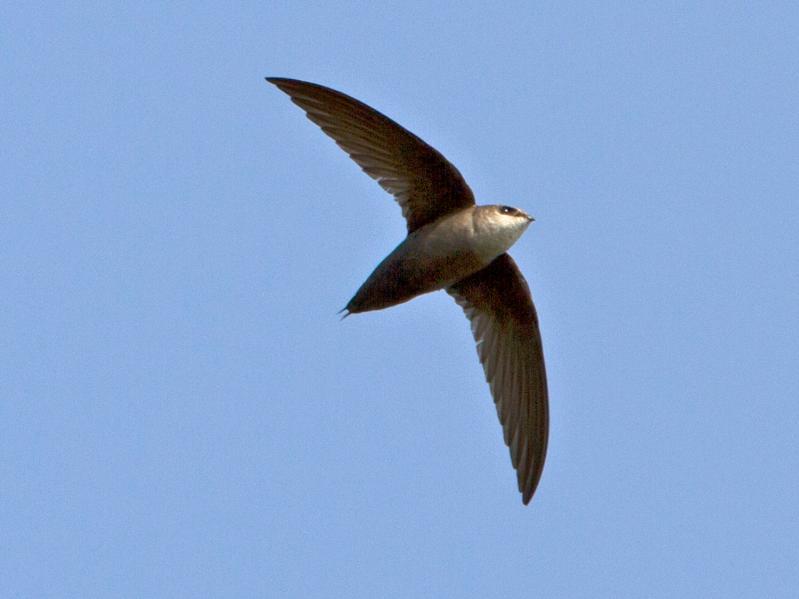If Canada is the roof of North America, its chimney is smoking. And with that smoke billowing down the East Coast in the last couple of weeks, it feels fitting to discuss a bird that depends on chimneys to breed: the chimney swift.
Unrelated to the Canada wildfires, this is the best time of year to observe these birds locally as they burst through the skies over our villages.
In Sag Harbor Village last week, early morning dog walkers and coffee getters walked by landscapers busy hanging pots of flowers while above it all, chimney swifts circled, noticed by almost no one. House sparrows and European starlings make their presence known, hopping about the sidewalk or calling from a low tree branch, but the chimney swifts are literally above all the fracas, and are more a part of the sky.
You’ll never see a chimney swift land, or even come close to street level. In their daily circuits, they can fly 500 miles a day in pursuit of something like 12,000 flying insects. According to the Chimney Swift Conservation Association, run by Paul and Georgean Kyle, they eat a third of their body weight daily. Take that, Mosquito Joe.
Even if you saw a chimney swift land you might not think much of it, as they’re rather bland looking: a mellow mix of brown, light brown and gray. Flying however, they are a wonder, with stiff, quick, shallow wingbeats. They gain momentum and then coast and curve in pursuit of invisible insects.
Their silhouettes are distinctive, the shape of a small boomerang. In keeping with the ash and smoke associations, Roger Tory Peterson, one of the fathers of the modern birding movement, described them as “a cigar with wings.”
If you’ve walked through any of our villages between May and October, you’ve certainly heard this bird. Its song, like its plumage, is not classically beautiful. It’s a non-melodic, staccato burst of high-pitched twitters and clicks, not some lovely melody whistled from a dew-laden branch. It is, however, the best clue that the bird is present. I often hear the song, look up, and see a couple of chimney swifts
overhead before they disappear behind a building or treetop.
Chimneys, cigars, a rattling call, and fleeting views; why focus on the chimney swift?
First, I think their name is a turnoff. It seems wrong that this bird, which is as much a part of the sky as the clouds, should be associated with something as dirty as a chimney, or cigars. A sky, cloud, or space swift is more apt, as it looks like a shape cut from the blue exposing the dark beyond.
Second, put simply, it eats things we humans hate, including mosquitoes, biting flies, and termites. We also love saving things we first push to the brink: ospreys, whales, the middle class.
Since there is a conservation group named for them, it should be clear that like many good things, the chimney swift is struggling. In fact, along with a decrease in nesting sites, insect populations are on the decline, and together these have caused a 67-percent decline in their population, according to the North American Breeding Bird Survey. By 2050, unless something changes, they’ll lose another half of their remaining population.
“Before the advent of the white man, this species very likely nested inside hollow trees, and perhaps cave walls,” wrote John Bull in his 1974 tome, “The Birds of New York.” No more. Turns out, like the purple martin, chimney swifts are now dependent on humans for their housing. But most homeowners cap their chimneys nowadays, to prevent squirrels and raccoons from entering their living rooms. However understandable that is, it has meant less nesting habitat for these highly beneficial birds.
So, what can you do? First, stop spraying pesticides, and plant native plants to support insect populations. Chimney swifts eat only insects. Spraying pesticides, organic or not, for anything, ticks included, kills all species of baby birds — not directly, but indirectly, as almost all nestlings rely on insects to grow. Their parents aren’t feeding them a sunflower seed from your feeder.
Second, and this may be a tough sell, build a swift tower, or encourage your local government to do so.
In “Chimney Swift Towers: New Habitat for America’s Mysterious Birds,” Paul and Georgean Kyle offer plans for 12-foot towers, but eight-foot towers could work as well, and seem like a project ripe for an Eagle Scout. They are not unattractive.
In Sag Harbor, the recently opened Steinbeck Park would be a perfect spot; in East Hampton Village, Herrick Park; in Bridgehampton, the fire department ball field, or perhaps the Children’s Museum of the East End; in Montauk, the village green. Disguise it as a lighthouse.
“The primary obstacle to their conservation,” wrote Mr. Kyle in an email, is that there will be only one active nest in any structure. However, unlike other birds who use a nesting box for only a month while they lay eggs and fledge their young, chimney swifts use their towers for their entire six-month stateside stay. “The tower is their home, a place to safely roost at night and find safety during unfavorable weather,” wrote Mr. Kyle.
Prior to fall migration, when they leave the United States for the Amazon, they brood communally. A tower could attract hundreds, or thousands, of birds and be a sunset spectacle, as they cloud up and filter into the tower, like smoke in reverse. Don’t believe me? Google “Portland swifts.”
“One more thought,” offered Mr. Kyle, “A chimney swift tower, even if it is never occupied, can act as an educational focal point for the plight of chimney swifts and thus aid in their conservation.”
They’re fleeting, like everything else, except the sky you’ll see them silhouetted against.

